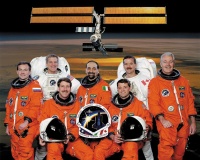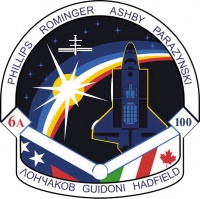STS-100
From The Space Library
 | |
| Organization | NASA-Office of Space Flight (United States) |
|---|---|
| Mission type | Engineering,Human Crew |
| Launch date | April 19, 2001 |
| Launch vehicle | Space Shuttle |
| Launch site | Cape Canaveral, United States |
| COSPAR ID | 2001-016A |
| Inclination | 51.6 degrees |
| Experiments | Here |
| Alternate Names | 26747 |
| Additional Information | Here |
| Data Collection | Here |
| Payload Mass Up | 13368.27 kg |
| Payload Mass Down | 9248.18 kg |
| Orbiter | Endeavour |
| Lift Off Mass | 2,055,566.36 kg |
| Orbiter Weight at Liftoff | 120,576.36 kg |
| Orbiter Weight at Landing | 100,056.82 kg |
| Landed | Concrete runway 22 at Edwards Air Force Base, Calif. |
| Orbits of Earth | 186 |
| Orbital Altitude | 240 nautical miles |
Contents |
[edit] Crew
- Commander: Kent V. Rominger
- Pilot: Jeffrey S. Ashby
- Payload Commander:
- Mission Specialist 1: Chris A. Hadfield, Canadian Space Agency
- Mission Specialist 2: John L. Phillips
- Mission Specialist 3: Scott E. Parazynski
- Mission Specialist 4: Umberto Guidoni, European Space Agency
- Mission Specialist 5: Yuri Valentinovich Lonchakov, Russian Air Force
- Payload Specialist 1:
- Payload Specialist 2:
ISS/Mir Crew Transport
[edit] Mission
STS 100 is an American shuttle spacecraft that was launched from Cape Canaveral at 18:41 UT on 19 April 2001 to dock with the International Space Station (ISS). It carried a crew of four Americans, one Russian, one Canadian and one Italian. The main mission was to install an 18 meter, 1,700 kg Canadian robotic arm named Canadarm-2 on the ISS, and to transport an Italian cargo container, Raffaello which delivered 4,500 kg of supplies and equipment to the station. It docked with the ISS at 13:59 UT on 21 April. The robotic arm was hooked to the ISS with the help of the shuttle's own 16 meter arm and two of the crew members. The seven-joint arm was not permanently bolted to the ISS, and will crawl along the exterior walls under computer control, temporarily anchoring wherever needed. There was a sequential failure of the three onboard computers on the ISS, but after four days of effort a backup computer was activated fairly enough to enable the Canadarm-2 to hand over its own packing crate to the shuttle arm. STS 100 undocked from the ISS on 29 April after retrieving Raffello, and landed at Edwards AFB in California on 01 May.
[edit] EVA
Extravehicular Activity (EVA) conducted by Scott Parazynski and Chris Hadfield during two space-walks for a total of 14 hours, 50 minutes. EVA 1, 7 hours, 10 minutes; Parazynski and Hadfield installed and deployed the UHF antenna on Destiny and began installation of Canadarm2. EVA 2, 7 hours, 40 minutes; Parazynski and Hadfield completed power and data connections on Canadarm2.
[edit] Payload
ISS Assembly Flight 6A; Raffaello Multi-Purpose Logistics Module; Space Station Remote Manipulator System (SSRMS), also known as Canadarm2; UHF antenna
[edit] Books about the Space Shuttle Program
Buy This Book Click here |
Buy This Book here |
Buy This Book Click here |
Buy This Book Click here |





